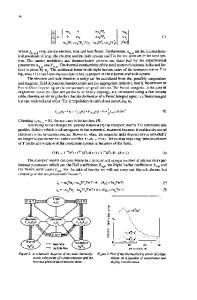Artificial neural network and finite element modeling of nanoindentation tests
- PDF / 1,820,482 Bytes
- 9 Pages / 612 x 792 pts (letter) Page_size
- 10 Downloads / 349 Views
I. INTRODUCTION
THE strength, fatigue, and fracture properties of multiphase metallic alloys strongly depend on the in-situ elastic and plastic flow properties of the individual constituents of the microstructure. However, the in-situ mechanical properties of the individual constituents are difficult to determine. The objective of this study is to extract stress-strain behavior of a local region of a material using the load-displacement behavior obtained during a nanoindentation test. The general indentation problem has old roots in elasticity and mechanics of solids. Prandtl[1] developed a slip-line field solution for a flat punch on a semi-infinite medium. Hill et al.[2] also considered a wedge indentation under plane strain conditions. Ishlinky[3] obtained a solution for spherical indentation. Shield[4] used an axisymmetric indentation model by a flat cylindrical punch. Tabor[5] studied the plastic deformed zone in elastic-plastic material as a result of spherical cavity expansion with an internal hydrostatic pressure, and Johnson[6] extended this study to include the effect of tip geometry. However, it is difficult to analytically describe the complex stress-strain field due to inelastic response and include detailed geometric parameters that may exist at different scales of the material. Different numerical techniques have been developed and can be used in indentation problems. Bhattacharya and Nix[7]
ANASTASIA MULIANA, Graduate Research Assistant, and RAMI M. HAJ-ALI, Assistant Professor, are with the School of Civil and Environmental Engineering, Georgia Institute of Technology, Atlanta, GA 30332-0355. Contact e-mail: [email protected] REJANAH STEWARD, formerly Graduate Research Assistant, School of Materials Science and Engineering, Georgia Institute of Technology, is with the Department of Material Science Engineering, University of Tennessee-Knoxville, TN 37996. ASHOK SAXENA, Professor and Chair, is with the School of Materials Science and Engineering, Georgia Institute of Technology. Manuscript submitted July 26, 2001. METALLURGICAL AND MATERIALS TRANSACTIONS A
used the finite element (FE) method to solve for an indentation problem with an axisymmetric cone. The cone shape is constrained to have the same volume as that of a pyramidshaped indenter for a given depth. Their FE hardness results compared well with experimental data. They also presented an elastoplastic analysis of axisymmetric conical indentation and showed that the shape of the plastic zone strongly depends on the indenter angle, Young’s modulus, and yield stress.[8] The FE analyses seem to predict an upper bound of the experimental results, while the spherical cavity model seems to predict a lower bound behavior. Wang and Bangret[9] used three-dimensional (3-D) FE models to investigate the indentation response in a coated system. Sun et al.[10] developed an axisymmetric FE model to simulate the indentation of a hard coating on a softer substrate using a conical indenter. The axisymmetric indenter is constrained to have the same pr
Data Loading...











